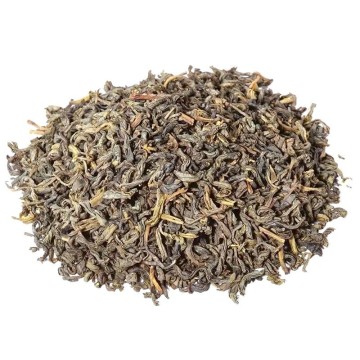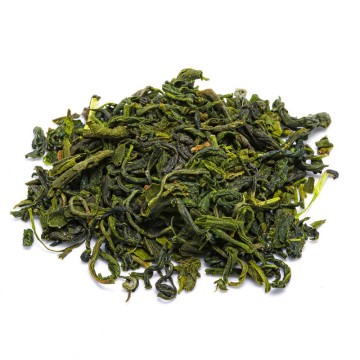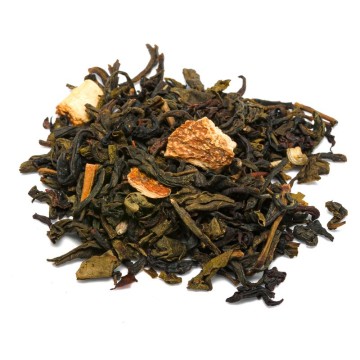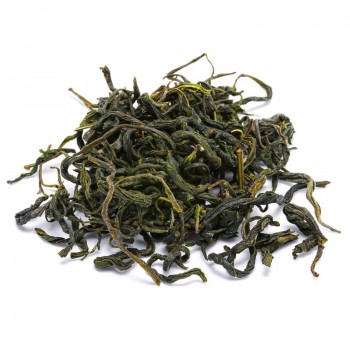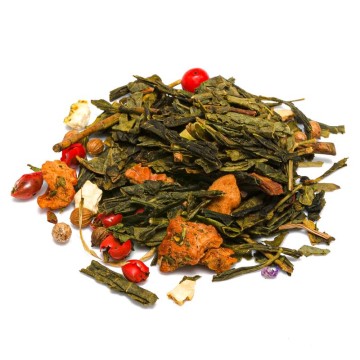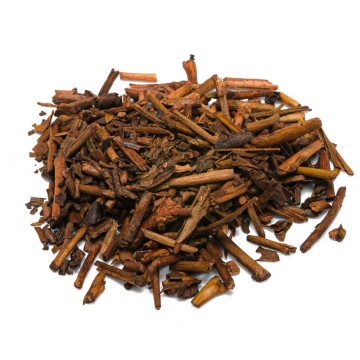Among the varieties of Japanese green tea, this particular infusion comes from a different practice than usual in harvesting the plant. Kukicha gives its properties not through the leaves, as usual, but through its composition with stems, stems and twigs of the Camellia sinensis plant. In most cases, stems that are already a few years old are used, making Kukicha the "three-year tea".
As a result of this aging, the twig contains less theine than others, while still retaining many other benefits for human well-being. It is a full-bodied light-colored tea, and due to its process the flavor is unique, slightly bitter and with sweet nuances; sometimes slightly nutty and with hints of honey. It shows an enveloping aroma reminiscent of the plant it comes from, especially in its version of Kukicha tea.
Properties and benefits of Kukicha green tea
This infusion brings several benefits to the body, precisely because of its particularity. Naturally contains a low content of theine (caffeine), and for this Kukicha is suitable for anyone looking for the benefits of green tea, avoiding the stimulating effects of theine (agitation, increased heart rate, headache, increased blood pressure) . It can be consumed at any time of the day, and provides the body with other beneficial nutrients as well. Kukicha tea is rich in vitamin A, C, and vitamins of the B complex. It also makes minerals such as calcium, copper, selenium, manganese and zinc bioavailable. In particular, the calcium content of Kukicha green tea represents a highly appreciated property for health. A cup of Kukicha tea contains more calcium than several glasses of cow's milk.
We know that regular consumption of calcium helps bone health, strengthens teeth and helps the proper functioning of muscle contraction, blood coagulation and the transmission of nerve impulses. Kukicha also contains fluoride, useful together with calcium to maintain the well-being of bone tissue and tooth enamel, also helping against the harmful bacteria of tooth decay. This green tea also shows a high content of L-theanine, an amino acid found in all types of tea, but usually in lower content.
Kukicha contains high levels of it because the amino acid is produced by the roots, and before reaching the leaves, it certainly passes through the twigs and stems that go into the infusion of this tea. Among the benefits of L-Theanine, is its ability to induce calmness, reducing stress but without providing a feeling of sleepiness. Usually, this element balances theine and creates an excellent effect of concentration and well-being, avoiding excessive excitement as occurs in coffee. In Kukicha, L-theanine works best, relaxing the nervous system but with good effects on alertness. This green tea also has a high content of antioxidants such as polyphenols and tannins; substances that counteract cellular aging and the damage caused by so-called free radicals.
Like polyphenols, green tea also provides other beneficial reactive substances such as catechins. Especially the element epigallocatechin (EGCG), which protects the well-being of the skin and our cells. For those who want to combine green tea with a purifying and slimming diet, Kukicha also contains these catechins, studied for their possible fat-burning effect. The polyphenol EGCG can favor the acceleration of the metabolism, acting on substances called catecholamines. It produces heat in fat and muscle tissue, increases the oxygen content and initiates fat burning. It can become a resource for releasing energy in the body, avoiding accumulations in fat.
To facilitate this process, green tea must be combined with a correct slimming diet. An important nutrient found in green teas such as Kukicha is ellagitannin, which gives the natural anti-inflammatory effects known in folk medicine in the past. In terms of antioxidants, Kukicha tea also contains a lot of vitamin C, another powerful element known to protect the immune system, skin and eyes. Kukicha is considered excellent in the same way for the digestive system, again due to the effect of the ellagitannin.
This phytochemical substance promotes the growth of good intestinal bacteria, with the function of promoting proper digestion, and avoiding constipation disorders. For those suffering from acidity, this Japanese green tea exhibits an alkalizing effect that decreases acidity when combined with a proper diet. It works thanks to its high levels of calciumand other minerals. Furthermore, green tea has purifying properties and even Kuchina in its green tea version encourages a draining effect for the expulsion of excess liquids. It can counteract water retention, helping against swelling in certain areas of the body.
Origins and History of cultivation
The Kukicha comes from the collection and infusion of the green parts of the Camellia sinensis plant: twigs, stems and stems, and not including the tea leaves. This type of tea was born in Japan, in the province of Shizuoka, as an economic tea for less well-off populations. The stems and stems of the tea plant were discarded during processing.
To avoid waste, the workers began to save the twigs, allocating them to a different infusion, a cheaper version of green tea. Its origin, from what in theory might have seemed useless parts, has actually revealed excellent nutritional properties. The name of Kukicha green tea, also called Bancha Kukicha tea, derives from the term kuki "sprig", immediately indicating its origin.
It was introduced in Europe only recently by George Ohsawa the founder of the macrobiotic diet. It was he who made it known as the "three-year tea", since the plant from which the twigs are harvested must be of this age. In the Kukicha green tea process, the branches are harvested and then trimmed and roasted, resulting in a darker tea. If they are not toasted, the color will be lighter and yellowish. The stalks, stems and twigs are usually mixed together, then cut evenly.
The stems will be withered and dried. In Japanese tradition, Kukicha can be consumed at any time of day, even during and after meals to aid digestion. Excellent to accompany rice and vegetables, with its delicate, slightly sweet and nutty flavour. In Japanese, when Kukicha is made from Gyokuro tea, it is often called "Karigane" or Shiraore". Kukicha made from Gyokuro is of the highest quality, while Kukicha made from Bancha is considered low quality.
Plant and flowers
Kukicha originates from the plant common to all types of tea, the Camellia sinensis. It is a shrub native to Southeast Asia, now also cultivated in other countries with tropical climates. The tea plant, sometimes called Thea sinensis), belongs to the Theaceae family. It represents a genus that brings together about 250 species of evergreen trees and shrubs. Left wild, the plant can reach 9 meters in height, but it is usually grown reduced to a low bush, to facilitate the collection of leaves or, as in this case, twigs, stems and stalks. It is pruned often to encourage the development of the young tea leaves. The woody shrub is highly branched and the young branches are reddish. Gives fragrant, yellow flowers, about 4 cm wide.
The flower is solitary and forms on the branches, and the shape and color also depend on the many varieties that have been selected and cultivated since the last century. Nutritional values of Kukicha green tea This Japanese tea contains good amounts of calcium, antioxidant polyphenols including the important EGCG Epigallocatechin gallate, and the amino acid L-theanine. Contains a low theine content (about 25 milligrams in a cup). Furthermore, it makes vitamin C (about 2%) and vitamins of group B (thiamine, riboflavin, niacin) available. In addition to calcium, it contains small amounts of protein, fiber, carbohydrates, and some minerals such as iron, magnesium, potassium, zinc.
How to prepare Kukicha Japan green tea
Kukicha green tea is obtained by placing about 3-5 grams of the infusion preparation in a cup (250 ml) with water at 80 °C. Leave to infuse for 2 to 3 minutes, before drinking the Japanese green tea infusion. If you want a more robust flavor, you can let it steep a few more minutes. Kukicha tea can also be served without sweeteners, but you can sweeten it with sugar, honey, or milk and honey if you like. It can be served hot or cold.
Kukicha Japan green tea: side effects and contraindications
Kukicha green tea usually does not show side effects. In any case, it is advisable to respect the recommended doses, to prevent the high levels of tannins from hindering the absorption of iron. Therefore, for those suffering from anemia, it is recommended to integrate Kukicha tea with foods rich in iron.

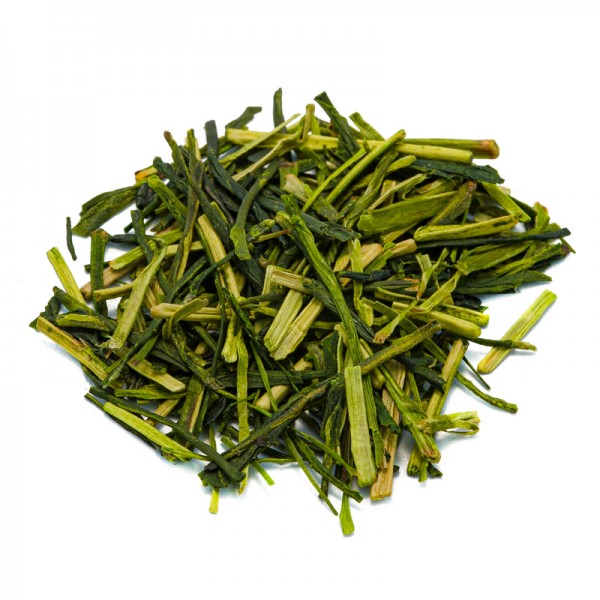







 No reward points for this product.
No reward points for this product.
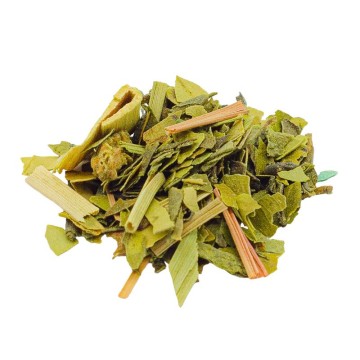

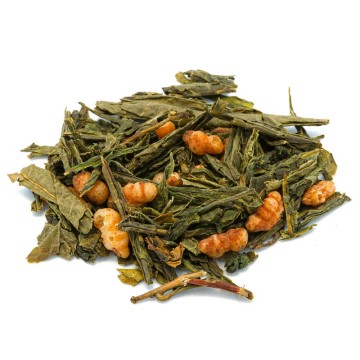
![Ginseng and ginger green tea [Natura d'Oriente]](https://www.naturadoriente.com/3367-home_default/Green-tea-ginseng-ginger.jpg)
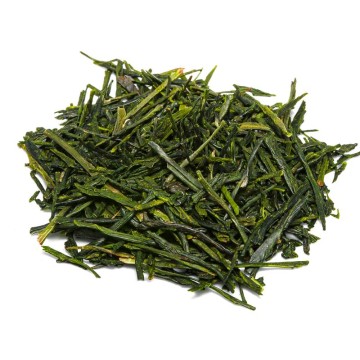
![Green Tea Choui Fong Tea [Natura d'Oriente]](https://www.naturadoriente.com/3379-home_default/green-tea-choui-fong-tea.jpg)
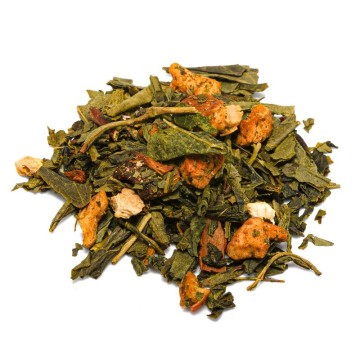
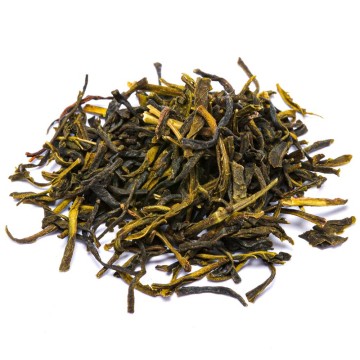
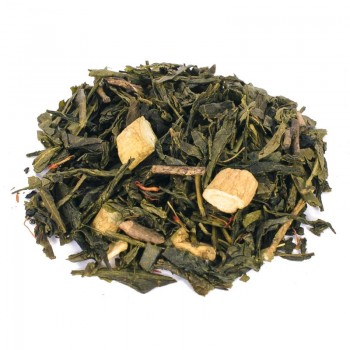
![Green Tea Sencha Kombucha [Natura d'Oriente]](https://www.naturadoriente.com/3380-home_default/-green-tea-sencha-kombucha-.jpg)
